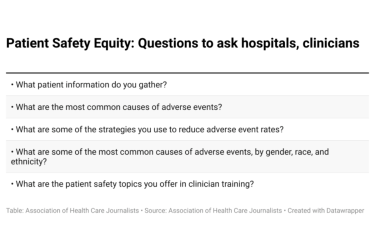
You might think that federal watchdogs who fight Medicare fraud would also deploy their powers to protect patients, since the schemes they prosecute often involve billing for risky, unnecessary treatments.
Very often, you’d be wrong.
Just how often was tallied by Michael Berens, an award-winning investigative reporter, in his Reuters special report, “How doctors buy their way out of trouble.” The article is self-described as the“first-ever comprehensive analysis” of federal civil settlements and state disciplinary actions.
It’s an example of what Berens refers to as stories that “are hidden in plain sight,” if only someone took the time to dig through documents, data and human stories.
In this case, Berens found that at least 540 individual practitioners and 2,200 institutions paid the government hefty civil settlements in the last decade without criminal charges or other further accountability. The vast majority continued to bill for services while affected patients remained in the dark about harms they may have incurred.
Berens shared his insights with HealthBeat.
Responses have been lightly edited for brevity and clarity.
What turned you on to this story, and how did you convince your editors to let you proceed?
Like many, no doubt, I routinely glossed over ubiquitous news briefs of federal civil settlements, often painted as medical billing disputes. Then I read a few cases. Behind the headlines were a menagerie of startling cases. Kickbacks, falsified diagnoses, unnecessary surgeries — hundreds of doctors accused of deceiving or harming patients. When I read that many paid hefty settlements to stay in business, sidestepped prosecution and were not required to admit liability, my journalism radar overloaded. I zeroed in on a New York surgeon accused of profiting from unwarranted cardiac procedures on elderly patients and a Michigan doctor accused of performing unnecessary radical hysterectomies. I wrote a multi-page pitch memo that underscored unique, data-driven findings — catnip for editors.
How long did it take to complete this project?
About 10 months from idea to launch, spanning more hours than I want to know. Early months focused on data collection and analysis — finding the right cases to highlight broader themes. The time investment will yield more stories this year.
You pieced this story together using many data sources. What were the most valuable sources, and what did you have to do to tap them?
The foundation was built from web-based indexes of public notices by the Department of Justice and Health and Human Services, Office of Inspector General. I scraped headlines from government web pages to spreadsheets, weeding out thousands of off-topic items, and coded each case into the spreadsheet under dozens of criteria. Links to agency portals are embedded in this how-we-did it sidebar. Coding cases allowed me to track repeat suspects and delineate cases of kickbacks, patient harm, medically unnecessary procedures, etc. Names of hundreds of doctors were hand-entered into other spreadsheets and cross-matched with state discipline data — case by case, state by state.
What was the most difficult part of the data gathering?
There is no central repository of civil settlements, which are scattered across federal courts and multiple agencies. Moreover, cases span multiple enforcers from the FBI and DEA to Homeland Security and Department of Defense. While most case details can be found in federal courts, dozens of civil actions each year are deemed internal actions by the Office of Inspector General, which often provides only scant information.
Would you recommend that other journalists do similar reporting on physicians and health care facilities in their own states or communities? What tips can you offer?
Civil settlements offer a rich tapestry of potential stories. Zero in on pharmacies, testing laboratories, faulty medical devices, home health scams, telemedicine fraud, patient dumping — it’s a wealth of journalism riches. Start small, perhaps with one year of cases and look for trends or anything that makes you say, “What?!” Zero in on a specific profession or topic, like spinal devices or urine testing. Go deep, selectively. And there’s gold in minutia — read footnotes, scour annual reports. Ask yourself basic questions: Who paid the highest settlement in my state this year?
Would most reporters have access to the Westlaw data that you used? If not, how could they obtain it?
Westlaw was a convenience, not a necessity. Most civil cases are publicly available via federal courts. Many case synopses are posted online for free on places like Casetext or Justia Law. The government’s PACER service, an online case lookup tool that costs 10 cents a page, is a portal to every federal case. Remember, you don’t need to pull full text on every case, just the ones that serve your needs. Call plaintiff attorneys and ask them to email PDFs of complaints, etc. Look for groups that track civil suits, like Good Jobs First.
There are plenty of stunning revelations in this piece. Is there one that stands out to you?
One that resonated for me was how victims are ignored in the government’s settlement calculus. There is no requirement to tell patients about evidence of harm. And documented patients/victims are not eligible to receive restitution in civil cases — even in cases of egregious harm, including death. The government keeps every penny.
Anything else you’d like to mention?
Develop a solid record-keeping system — take a few extra minutes to organize your material now and save hours during crunch time. When someone tells you that a settlement is no big deal, a misunderstanding of medical billing procedures, a mere financial misstep, then dig in and look deeper. Often, there are hidden victims.








